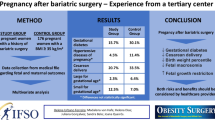Abstract
Background
Increasing numbers of pregnancies are seen in obese women treated surgically with laparoscopic adjustable gastric banding (LAGB). We compared their maternal and fetal outcomes with obese women without LAGB and normal-weight controls.
Methods
Sixty-nine obese women with LAGB (83 pregnancies) were compared with 120 obese women without LAGB and 858 controls.
Results
By comparison with normal controls, post-LAGB pregnancies had higher rates of gestational hypertension (9.6% vs 2.4%, p < 0.05), preeclampsia/eclampsia (12.0% vs 2.3%, p < 0.001), abortion (10.8% vs 0.3%, p < 0.001), cesarean section (45.9% vs 28.2%, p < 0.01), preterm delivery (17.6% vs 3.6%, p < 0.001), and babies needing neonatal intensive care (20.3% vs 9.0%, p < 0.01). Compared with the no-LAGB obese group, the post-LAGB pregnancies had lower rates of gestational hypertension (9.6% vs 23.5%, p < 0.05), preeclampsia/eclampsia (12.0% vs 20.8%, p < 0.05), and cesarean section (45.9% vs 65.8%, p < 0.01). The post-LAGB obese women gained less weight during the pregnancy (6.6 ± 7.9 vs 14.8 ± 10.1 kg, p < 0.001) and experienced less gestational hypertension (14.8% vs 33%), preeclampsia/eclampsia (7.4% vs 14.8%), and macrosomia (4.2% vs 16%) than in pregnancies before LAGB. No significant differences in maternal and fetal outcomes emerged between post-LAGB pregnant women who lost versus those who gained weight during pregnancy. Compared with those no longer morbidly obese, women still morbidly obese after LAGB had a lower weight gain (2.8 ± 11.8 vs 8.6 ± 9.5 kg, p < 0.05) and a higher gestational hypertension rate (29.4% vs 8.9%, p < 0.05).
Conclusion
The risks of negative maternal and fetal outcomes for obese women can be reduced by LAGB if the women are closely followed up.

Similar content being viewed by others
References
Flegal KM, Graubard BI, Williamson DF, et al. Excess deaths associated with underweight, overweight and obesity. JAMA. 2005;293:1861–7.
Hedley AA, Ogden CL, Johnson CL, et al. Prevalence of overweight and obesity among US children, adolescents and adults. 1999–2002. JAMA. 2004;29:720–33.
Cnattingius S, Bergstrom R, Lipworth J, et al. Prepregnancy weight and the risk of adverse outcomes. N Engl J Med. 1998;338:147–52.
Sebire NJ, Jolly M, Harris JP, et al. Maternal obesity and pregnancy outcome: a study of 287,213 pregnancies in London. Int J Obes Relat Metab Disord. 2001;25:1175–82.
Cedergen MI. Maternal morbid obesity and the risk of adverse pregnancy outcome. Obstet Gynecol. 2004;103:219–24.
Galtier-Dereure F, Montpeyroux F, Boulot P, et al. Weight excess before pregnancy: complications and costs. Int J Obes Relat Metab Disord. 1995;19:443–8.
Dixon JB, Dixon ME, O’Brien PE. Pregnancy after Lap-Band surgery: management of the band to achieve healthy weight outcomes. Obes Surg. 2001;11:59–65.
Buchwald H, Avidor Y, Braunwald E, et al. Bariatric surgery. A systematic review and meta-analysis. JAMA. 2004;2292:1724–37.
Kral JG, Naslund E. Surgical treatment of obesity. Nature Clin Pract Endocrinol Metab. 2007;3(8):574–83.
Weintraub AY, Levy A, Levi I, et al. Effect of bariatric surgery on pregnancy outcome. Int J Gynecol Obstet. 2008;103:246–51.
Dixon JB, Dixon ME, O’Brien PE. Birth outcomes in obese women after laparoscopic adjustable gastric binding. Obstet Gynecol. 2005;5:965–72.
Wittgrove AC, Facs LG, Wittgrove P, et al. Pregnancy following gastric bypass for morbid obesity. Obes Surg. 1998;8:461–4.
Sheiner E, Balaban E, Dreiher J, et al. Pregnancy outcomes in patients following different types of bariatric surgery. Obes Surg. 2009;19:1286–92.
Kral JG, Biron S, et al. Large maternal weight loss from obesity surgery prevents transmission of obesity to children who were followed for 2 to 18 years. Pediatrics. 2006;118(6):1644–9.
Granstrom L, Granstrom L, Backman L. Fetal growth retardation after gastric banding. Acta Obstet Gynecol Scand. 1990;69:533–6.
Martin L, Chavez GF, Adams Jr MJ, et al. Gastric bypass surgery as a maternal risk factor for neural tube defect. Lancet. 1998;1:640–1.
Ramierz MM, Turrentine MA. Gastrointestinal hemorrhage during pregnancy in a patient with a history of vertical-banded gastroplasy. Am J Obstet Gynecol. 1995;173:1630–1.
Eerdekens A, Debeer A, Van Hoey G, et al. Maternal bariatric surgery: adverse outcomes in neonates. Eur J Pediatr. 2009. doi:10.1007/s0043-009-1005-1.
National Institutes of Health. Hubbard VS, Hall VH. Gastrointestinal surgery for severe obesity. National Institutes of Health Consensus Development Conference draft statement. Obes Surg. 1991;1:257–65.
Favretti F, Segato G, Ashton D, et al. Laparoscopic adjustable gastric banding in 1,791 consecutive obese patients: 12-year results. Obes Surg. 2007;17:168–75.
Busetto L, Segato G, De Marchi F, et al. Post-operative management of laparoscopic banding. Obes Surg. 2003;13:121–7.
Carpenter MW, Coustan DR. Criteria for screening tests for gestational diabetes. J Obstet Gynaecol. 1982;144:768–73.
Metzger BE, Coustan DR. Summary and recommendations of the fourth international workshop–conference on gestational diabetes mellitus. Diab Care. 1998;20 Suppl 2:B161–7.
National High Blood Pressure Education Program Working Group on High Blood Pressure in Pregnancy. Report of the National High Blood Pressure Education Program Working Group on high blood pressure in pregnancy. Am J Obstet Gynecol. 2000;183(Suppl 1):S1–S22.
Parazzini F, Cortinovis I, Bortulus R, et al. Weight at birth by gestational age in Italy. Hum Reprod. 1995;10:1852–63.
Skull AJ, Slater GH, Duncombe JE, et al. Laparoscopic adjustable banding in pregnancy: safety, patient tolerance and effect on obesity-related pregnancy outcomes. Obes Surg. 2004;14:230–5.
Ducarme G, Revaux A, Rodrigues A, et al. Obstetric outcome following laparoscopic adjustable gastric banding. Int J Gynaecol Obstet. 2007;98:244–7.
CEDAP 2005. Ministero della Salute. www.ministerosalute.it
Conflict of interest
The authors declare no conflict of interest.
Author information
Authors and Affiliations
Corresponding author
Rights and permissions
About this article
Cite this article
Lapolla, A., Marangon, M., Dalfrà, M.G. et al. Pregnancy Outcome in Morbidly Obese Women Before and After Laparoscopic Gastric Banding. OBES SURG 20, 1251–1257 (2010). https://doi.org/10.1007/s11695-010-0199-7
Published:
Issue Date:
DOI: https://doi.org/10.1007/s11695-010-0199-7




